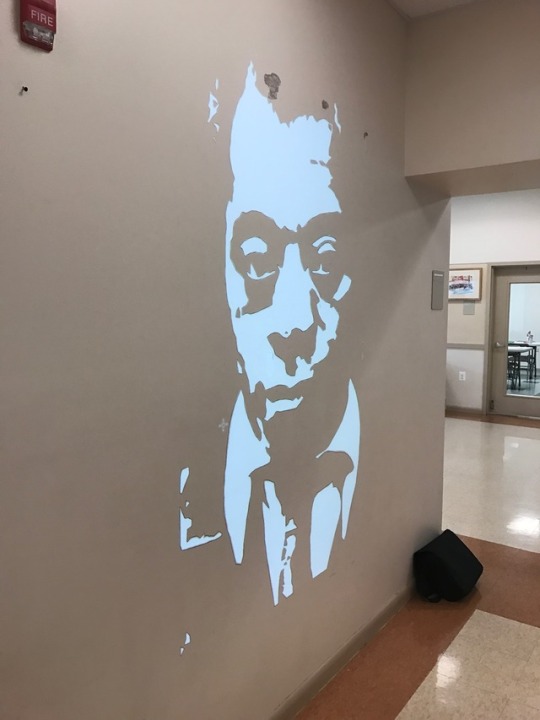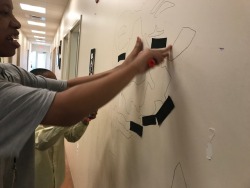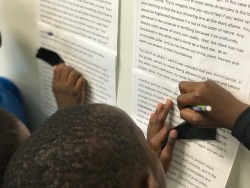 |
| Beckett Life Center, James Baldwin, 2018, Paper, pencil, glue, 5x8' |
Using pieces of black scrap paper, each piece with a word from Baldwin's Letter To My Nephew, artists at Beckett Life Center, aged 5-11, came together, respectively, as cogs in a well-oiled machine, learning roles like, "Writer, Sticker, Runner, Gluer, Counter," and gradually (not without a struggle!) began to cooperate as this chain of activity, their distinct duties as links in our sequence, bringing this collective piece to life, while having the individual goal of: "Finding your flow" and getting to that point where you're lost in the activity and moving without thinking.
Nakiya, was another "180." She had been, probably, one of the most defiant students we've had this year. She would walk in the room, already combative, fighting whomever was in front of her, especially the instructors. I wasn't alone. I found out she was doing it with the staff and with the other programs she was in at the Center. She was developing this "hatred" for me. I could hear her talking to her partner in crime about how she felt (and other things I'd rather not repeat). Pretending not to hear that and going over to encourage and help with art activity only to face an outright "no" (which you find at that moment emphatically re-defined and meant more than the usual two letters do) isn't easy. All you can do is choose your battles, and look for traces of constructive behavior to acknowledge and reward, and hope to disrupt this antagonistic rapport.
We were making mosaics using the left-over plates from our plate project last semester. To avoid any [shenanigans], I broke the plates at home and brought in selected pieces ready for them to place and paste. But then we ran out. There were a couple plates in the closet we could break. All the students wanted to break them, including Nakiya. I was telling them no, and that I was going to do it myself. I realized, though, that the way I was going to do it--wrapping the plates in cloth and then putting them in several plastic bags was about as dangerous as dropping a stack of paper on the ground. I noticed that Nakiya had been working steadily on her mosaic, albeit after some protesting and rudeness. Since she's the oldest in the class, it seemed appropriate to pick her and say, "If you finish what you're working on and make sure you use all the pieces you have left, I'll let you smash these plates outside."
She kept her end of the bargain, so I kept mine. We went outside and as I was stressing the safety precautions--even exaggerating them unnecessarily--I noticed I wasn't having to repeat myself or struggle for her attention. She was listening and standing where I had asked her to, waiting for the next direction. When she smashed the plates, she smiled and seemed happy that she was able to, like she got a little rush from the experience. I turned to her and said, "Ok, so now are you gonna stop giving me dirty looks?" Still smiling, she said, "Yes."
After that, she was a different person. With the mural, she began as a "gluer" and got on the other students for not catching up with their roles before and after hers. They started working harder. Nakiya was leading them. They were getting things done. They were finding their flow--so much so, that they asked to skip their scheduled 4:30p meal so they could stay longer to work on the mural. At 5p I was having to ask them to stop--several times to their protests. I didn't mind repeating myself this time. I only got them to stop when I said they could continue working on James Baldwin the next day without me. They did and when I came back, I didn't find any mistakes or disasters or anything other than what it would look like if I were there--and they got a lot done.



























